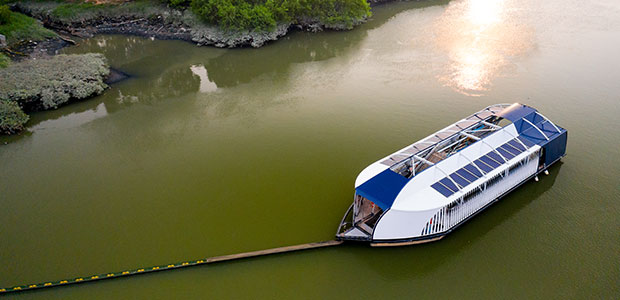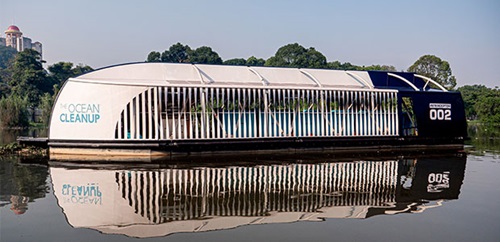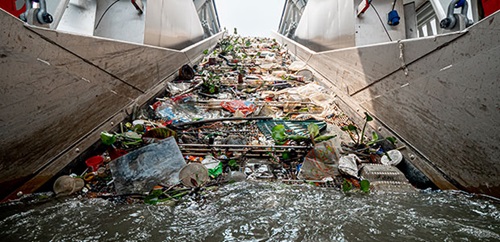
Solving the Plastic Pollution Problem: Ocean Cleanup Interceptor Releases a Floating Solution
Dutch non-profit called The Ocean Cleanup just launched the Interceptor—a kind of autonomous, water vacuum to collect trash and plastic before it reaches the ocean. This massive cleanup effort is part of its overall goal of lessening plastic waste worldwide.
At least eight million tons of plastic end up in the oceans each year, reports the International Union for Conservation of Nature (IUCN) – and yet, each year the globe sees a production of 300 million tons of new plastic. Many environmentalists and policy makers wonder what kind of massive solution is needed for this massive problem. A non-profit called The Ocean Cleanup may have just come up with a revolutionary step.
Plastics are littering oceans, rivers, and lakes, breaking down into smaller particles. A significant percentage of the plastic that enters the oceans from rivers and other sources drifts into large systems of circulating ocean currents, known as gyres. Once trapped in a gyre, the plastic slowly degrades into microplastics, contaminating ecosystems and water sources.
But this is not just about the environment and the wildlife that live underwater—aquatic pollution affects everything from species, ecosystems, human health, coastal tourism, and contributes to climate change. For a more in-depth glimpse of just how intensive this problem is, just visit PlasticPolution.org.
As complex and overwhelming as this issue is, the Interceptor is doing something about it.
Imagine a big pool net—but solar powered, autonomous, and floating down a river. The Interceptor is a recently-released, 100 percent solar powered, autonomous system for collecting plastic pollutions from rivers before it reaches the sea. Plus, its advanced technology allows it to move with currents, just like plastic, to avoid needing much operational energy.

The device’s solar panels charge lithium-ion batteries, which allow the plant to run 24 hours a day, seven days a week, without noise or carbon emissions.
Why can’t boats go out and collect trash? Going after floating plastics with individual vessels and nets would be costly, time-consuming, labor-intensive, and lead to a large amount of carbon emissions. That’s why a device like the Interceptor is incredibly important—and why it needs to operate sustainably.
“To truly rid the oceans of plastic, we need to both clean up the legacy and close the tap, preventing more plastic from reaching the oceans in the first place,” said The Ocean Cleanup founder Boyan Slat.
The initiative behind the massive machine hopes to make as much progress in plastic cleanup as soon as possible. Together with corporations and governments around the world, The Ocean Cleanup plans to address 1,000 of the most polluting rivers around the world in the next five years.
But it won’t stop there. The Ocean Cleanup is a project, and its goal is to reach a 90 percent reduction of floating ocean plastic by the year 2040. The Ocean Cleanup has estimated to be able remove 50 percent of the Great Pacific Garbage Patch every five years.
How does the machine work on the inside? The device consists of floating barriers attached to processing plants that resemble barges and are anchored to the river bed. The barriers funnel plastic waste into the plant’s mouth. Then, a conveyor belt separates the waste from the water and moves it up a shuttle. The shuttle then automatically dumps the waste into containers on a separate barge docked beneath, explains a Dezeen article.
When containers are full, the onboard computer system notifies local partners to bring a boat and tow the barge of plastic waste away for recycling. Each system only spans a part of the river, so boats and wildlife movement are not largely impeded.

According to The Ocean Cleanup, one Interceptor can extract 50,000 kilograms of trash from a river each day. Under “optimized conditions,” this level could reach up to 100,000 kilograms.
The Ocean Cleanup project will focus on the world’s most polluted rivers. This will significantly reduce the floating trash problem, as data shows that 80 percent of the ocean’s trash comes from just one percent of the world’s rivers. Take a look at the project’s interactive map to see for yourself.
Two Interceptor systems are already operating in Klang, Malaysia and Jakarta, Indonesia. A third Interceptor will soon be in operation in the Mekong Delta in Vietnam, while a fourth is on its way to Santo Domingo in the Dominican Republic.
The Ocean Cleanup has launched other marine pollution projects, including one to address the Great Pacific Garbage Patch. System 001, nicknamed Wilson, is a floating rig designed to similarly collect plastic. However, it has had a handful of major complications, including a fracture in January 2019 that required it to be towed to Hawaii for repairs.
The improved version of System 001 has collected some plastic, including some pieces as small as one millimeter, according to The Ocean Cleanup. Plastic collected by “Wilson” will be recycled or burned to generate electricity.
There is no doubt initiatives like System 001 and the Interceptor are doing good for the environment—and making large impacts. However, they do not come without their share of critique. One major contention against these ocean cleanup efforts is that they do not address the root of the issue: the mass production of plastic over other materials, the failing systems of recycling and public environmental education, and the overall illusion that picking up ocean trash is a broadscale solution.
Cyrill Gutsch, founder of Parley for the Oceans, has warned that cleaning up all the plastic already in the sea may be an impossible task. Plus, he told Dezeen that the focus should be on creating alternatives to plastic, not picking up the plastic trail.
“I just think we will not get plastic under control,” Gutsch said. “And I don't want to be creating the wrong illusion that we are able to clean up the ocean, because I don't think we are.”
The ICUN agrees that a waste cleanup solution is not the whole solution. It states on its website:
“Governments, research institutions and industries also need to work collaboratively redesigning products, and rethink their usage and disposal, in order to reduce microplastics waste from pellets, synthetic textiles and tyres. This will require solutions which go beyond waste management, to consider the whole lifecycle of plastic products, from product design to infrastructure and household use.
That being said, there is something to be celebrated for The Ocean Cleanup’s newest eco-friendly Interceptor. If it continues at the successful rate it’s at, the project could be well on its way to reducing the amount of river and ocean pollution within just a few years. Visit The Ocean Cleanup’s YouTube video on the project to see more.